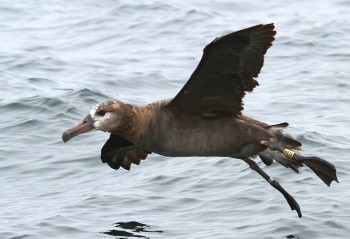A report by Jason Jannot (Fishery Resource Analysis and Monitoring Division, Northwest Fisheries Science Center, Seattle, Washington, USA) and colleagues show that longline and trawl vessels kill mainly Black-footed Albatrosses Phoebastria nigripes among the three species of North Pacific albatrosses in USA’s west coast (Pacific) fisheries
A shortened version of the report’s Executive Summary follows:
“The California Current Ecosystem on the U.S. West Coast (Washington, Oregon, and California) supports a diversity of marine organisms, including seabirds. This report summarizes interactions between the U.S. West Coast groundfish fishery and seabirds, and presents estimates of fleetwide seabird bycatch based on data from the fishery and federal observer programs for the years 2002–16.
Lethal and nonlethal interactions, as well as sightings, are presented for five fishery sectors using hook-and-line gear, six sectors using trawl gear, and four sectors using pot gear. A total of 41 species interacted with or were sighted in these fisheries over the 2002–16 period. Twelve species are considered endangered, threatened, vulnerable, or near-threatened by the U.S. Endangered Species Act (ESA) or the International Union for Conservation of Nature. The remaining 28 species are either not listed, or categorized as Least Concern (i.e., not at risk).
Three albatross species interact with these fisheries: black-footed, Laysan, and the ESA-listed short-tailed albatross.
To date, only one short-tailed albatross has been observed killed by these fisheries, and the mean estimated mortality for most years is less than one individual per year (Figure ES-1). However, black-footed albatross are consistently killed in a number of fishery sectors reported here. Laysan albatross have occasionally been killed by these fisheries, but the mortalities are few and infrequent. The estimated mean of non-short-tailed albatross mortalities ranged from a low of about 60 individuals in 2002 to a high of about 160 individuals in 2011 (see Other Albatross in Figure ES-1). The 2016 mean estimate of other (non-short-tailed) albatross was about 90 individuals. Other birds (i.e., not albatross) also showed a peak in mortality during the 2009–11 period of about 180–200 birds killed. The 2016 mean estimated mortality of other birds was about 120.
Hook-and-line fisheries account for the largest number of albatross taken among the three gear categories (hook-and-line, trawl, and pot). Hook-and-line fisheries account for 58–83% of seabird mortality in a given year, followed by trawl fisheries at 13–37%, and pot fisheries at 0–8% of bycatch in a given year (Table ES-1). The largest number of albatross taken comes from Limited Entry sablefish vessels fishing hook-and-line gears. This prompted regulations requiring streamer lines on hook-and-line vessels fishing in U.S. West Coast groundfish fisheries to be implemented in 2015. Bycatch of other species is generally split evenly between hook-and-line and trawl gears. Seabird mortality is likely underestimated on trawl vessels, because seabirds can be killed or injured by striking cables that exit aft of the vessel during trawling. These cables are not routinely monitored in these fisheries. Significant levels of bycatch, especially of albatross, have been recorded in similar trawl fisheries around the globe (Favero et al. 2011, Maree et al. 2014, Tamini et al. 2015). Pot gears appear to catch very few seabirds.”

Colur-banded Black-footed Albatross at sea, photograph by Vicki Miller
With thanks to Mi Ae Kim.
Reference:
Jannot, J.E., Somers, K.A., Tuttle, V., McVeigh, J. & Good, T.P. 2018. Seabird Mortality in U.S. West Coast Groundfish Fisheries, 2002–16. U.S. Department of Commerce, NOAA Technical Memorandum NMFS-NWFSC-146.
John Cooper, ACAP Information Officer, 12 March 2019

 English
English  Français
Français  Español
Español